

Getting started with Dgraph tutorials series - 5: Tweet graph, string indices, and keyword-based searching
Welcome to the fifth episode of getting started with Dgraph. In the previous episode, we learned about using multi-language strings and operations on them using language tags.
In this episode, we’ll model tweets in Dgraph and, using it, we’ll learn more about string indices in Dgraph.
We’ll specifically learn about:
- Modeling tweets in Dgraph.
- Using String indices in Dgraph
- Querying twitter users using the
hashindex. - Comparing strings using the
exactindex. - Searching for tweets based on keywords using the
termindex.
- Querying twitter users using the
Here’s the complimentary video for this blog post. It’ll walk you through the steps of this getting started episode.
Let’s start analyzing the anatomy of a real tweet and figure out how to model it in Dgraph.
Modeling a tweet in Dgraph
Here’s a sample tweet.
Test tweet for the fifth episode of getting started series with @dgraphlabs.
— Karthic Rao (@hackintoshrao) November 13, 2019
Wait for the video of the fourth one by @francesc the coming Wednesday! #GraphDB #GraphQL
Let’s dissect the tweet above. Here are the components of the tweet:
-
The Author
The author of the tweet is the user
@hackintoshrao. -
The Body
This component is the content of the tweet.
Test tweet for the fifth episode of getting started series with @dgraphlabs. Wait for the video of the fourth one by @francesc the coming Wednesday! #GraphDB #GraphQL
-
The Hashtags
Here are the hashtags in the tweet:
#GraphQLand#GraphDB. -
The Mentions
A tweet can mention other twitter users.
Here are the mentions in the tweet above:
@dgraphlabsand@francesc.
Before we model tweets in Dgraph using these components, let’s recap the design principles of a graph model:
NodesandEdgesare the building blocks of a graph model. May it be a sale, a tweet, user info, any concept or an entity is represented as a node. If any two nodes are related, represent that by creating an edge between them.
With the above design principles in mind, let’s go through components of a tweet and see how we could fit them into Dgraph.
The Author
The Author of a tweet is a twitter user. We should use a node to represent this.
The Body
We should represent every tweet as a node.
The Hashtags
It is advantageous to represent a hashtag as a node of its own. It gives us better flexibility while querying.
Though you can search for hashtags from the body of a tweet, it’s not efficient to do so. Creating unique nodes to represent a hashtag, allows you to write performant queries like the following: Hey Dgraph, give me all the tweets with hashtag #graphql
The Mentions
A mention represents a twitter user, and we’ve already modeled a user as a node. Therefore, we represent a mention as an edge between a tweet and the users mentioned.
The Relationships
We have three types of nodes: User, Tweet, and Hashtag.
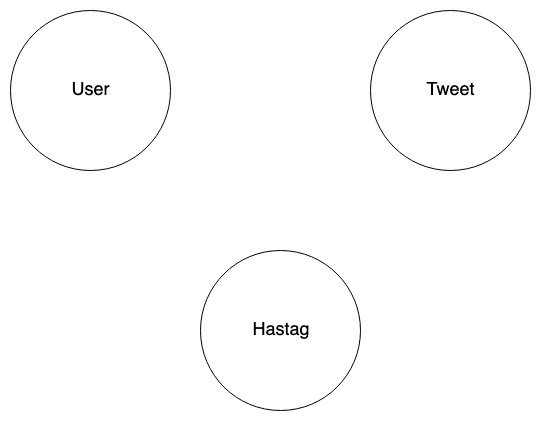
Let’s look at how these nodes might be related to each other and model their relationship as an edge between them.
The User and Tweet nodes
There’s a two-way relationship between a Tweet and a User node.
- Every tweet is authored by a user, and a user can author many tweets.
Let’s name the edge representing this relationship as authored .
An authored edge points from a User node to a Tweet node.
- A tweet can mention many users, and users can be mentioned in many tweets.
Let’s name the edge which represents this relationship as mentioned.
A mentioned edge points from a Tweet node to a User node.
These users are the ones who are mentioned in the tweet.
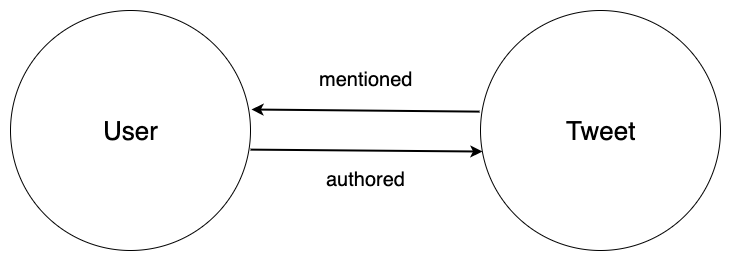
The tweet and the hashtag nodes
A tweet can have one or more hashtags.
Let’s name the edge, which represents this relationship as tagged_with.
A tagged_with edge points from a Tweet node to a Hashtag node.
These hashtag nodes correspond to the hashtags in the tweets.
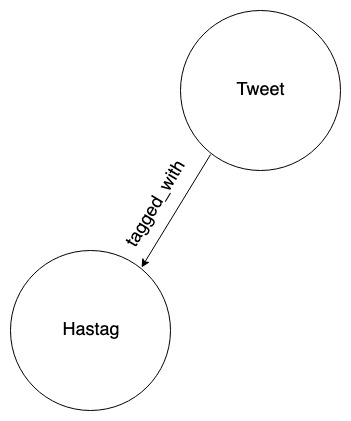
The Author and hashtag nodes
There’s no direct relationship between an author and a hashtag node. Hence, we don’t need a direct edge between them.
Our graph model of a tweet is ready! Here’s it is.
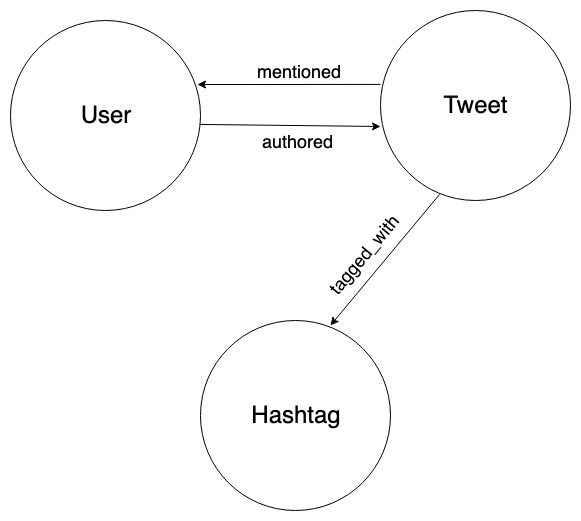 Here is the graph of our sample tweet.
Here is the graph of our sample tweet.
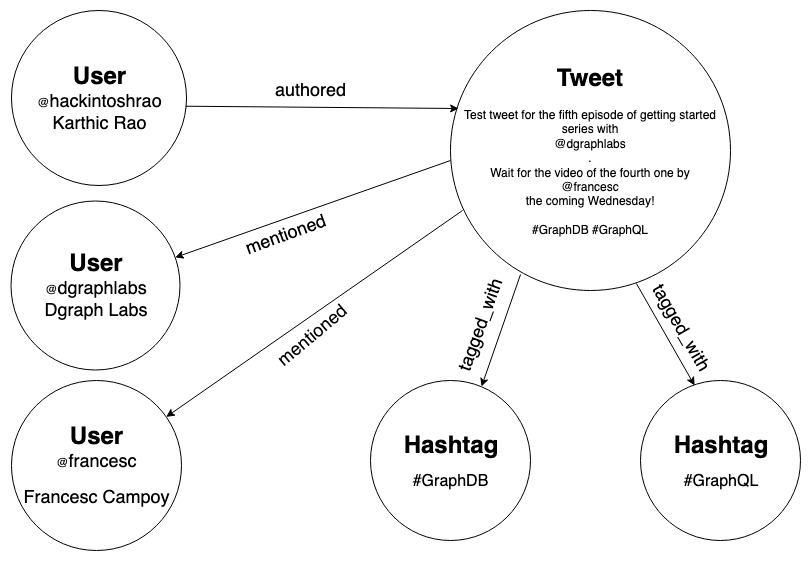
Let’s add a couple of tweets to the list.
So many good talks at #graphqlconf, next year I'll make sure to be *at least* in the audience!
— francesc (@francesc) June 21, 2019
Also huge thanks to the live tweeting by @dgraphlabs for alleviating the FOMO 😊#GraphDB ♥️ #GraphQL https://t.co/5uDpbswFZi
Let's Go and catch @francesc at @Gopherpalooza today, as he scans into Go source code by building its Graph in Dgraph!
— Dgraph Labs (@dgraphlabs) November 8, 2019
Be there, as he Goes through analyzing Go source code, using a Go program, that stores data in the GraphDB built in Go!#golang #GraphDB #Databases #Dgraph pic.twitter.com/sK90DJ6rLs
We’ll be using these two tweets and the sample tweet, which we used in the beginning as our dataset. Open Ratel, go to the mutate tab, paste the mutation, and click Run.
{
"set": [
{
"user_handle": "hackintoshrao",
"user_name": "Karthic Rao",
"uid": "_:hackintoshrao",
"authored": [
{
"tweet": "Test tweet for the fifth episode of getting started series with @dgraphlabs. Wait for the video of the fourth one by @francesc the coming Wednesday!\n#GraphDB #GraphQL",
"tagged_with": [
{
"uid": "_:graphql",
"hashtag": "GraphQL"
},
{
"uid": "_:graphdb",
"hashtag": "GraphDB"
}
],
"mentioned": [
{
"uid": "_:francesc"
},
{
"uid": "_:dgraphlabs"
}
]
}
]
},
{
"user_handle": "francesc",
"user_name": "Francesc Campoy",
"uid": "_:francesc",
"authored": [
{
"tweet": "So many good talks at #graphqlconf, next year I'll make sure to be *at least* in the audience!\nAlso huge thanks to the live tweeting by @dgraphlabs for alleviating the FOMO😊\n#GraphDB ♥️ #GraphQL",
"tagged_with": [
{
"uid": "_:graphql"
},
{
"uid": "_:graphdb"
},
{
"hashtag": "graphqlconf"
}
],
"mentioned": [
{
"uid": "_:dgraphlabs"
}
]
}
]
},
{
"user_handle": "dgraphlabs",
"user_name": "Dgraph Labs",
"uid": "_:dgraphlabs",
"authored": [
{
"tweet": "Let's Go and catch @francesc at @Gopherpalooza today, as he scans into Go source code by building its Graph in Dgraph!\nBe there, as he Goes through analyzing Go source code, using a Go program, that stores data in the GraphDB built in Go!\n#golang #GraphDB #Databases #Dgraph ",
"tagged_with": [
{
"hashtag": "golang"
},
{
"uid": "_:graphdb"
},
{
"hashtag": "Databases"
},
{
"hashtag": "Dgraph"
}
],
"mentioned": [
{
"uid": "_:francesc"
},
{
"uid": "_:dgraphlabs"
}
]
},
{
"uid": "_:gopherpalooza",
"user_handle": "gopherpalooza",
"user_name": "Gopherpalooza"
}
]
}
]
}
Note: If you’re new to Dgraph, and yet to figure out how to run the database and use Ratel, we highly recommend reading the first article of the series
Here is the graph we built.
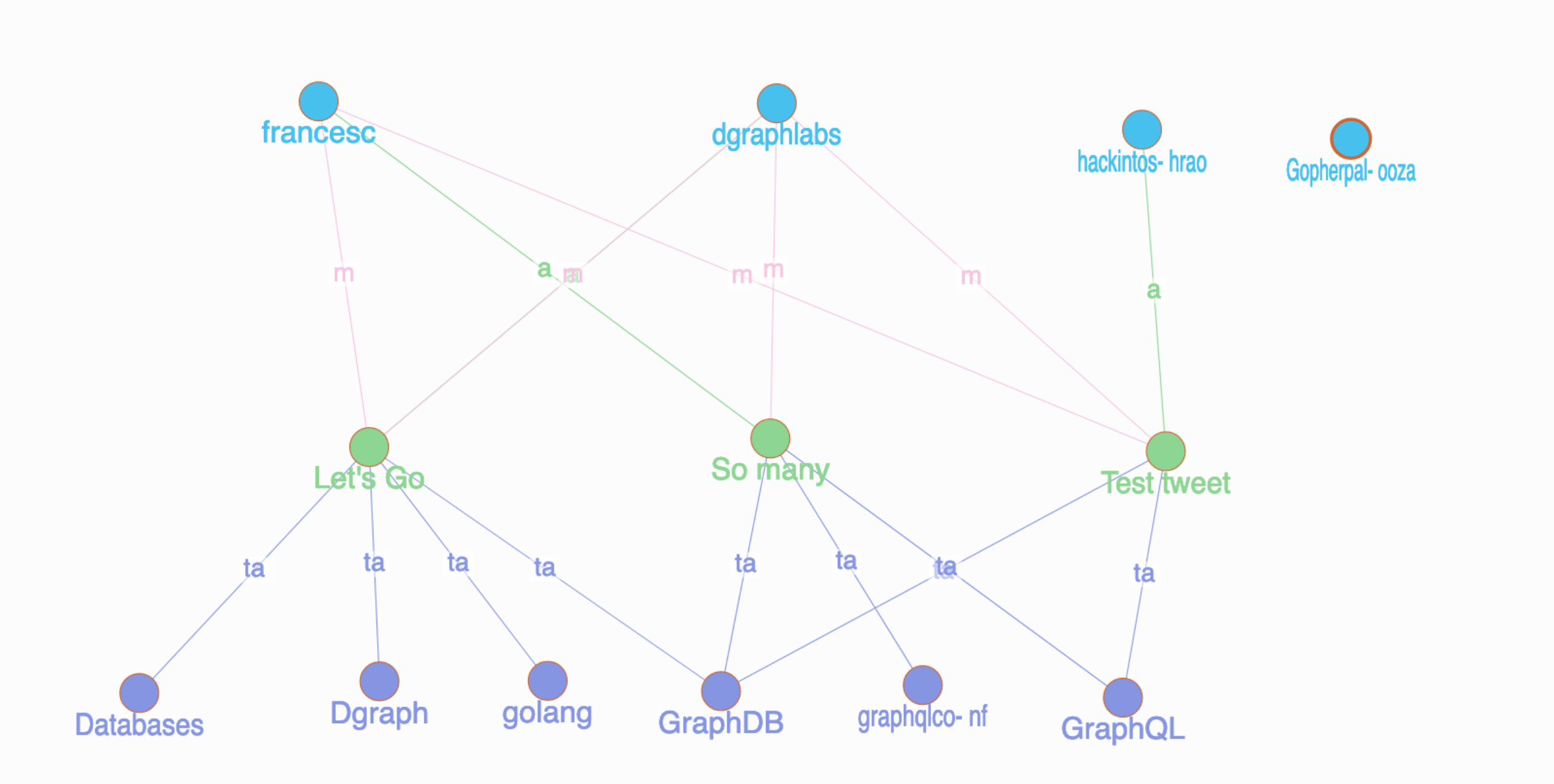
Our graph has:
- Five blue twitter user nodes.
- The green nodes are the tweets.
- The blue ones are the hashtags.
Let’s start our tweet exploration by querying for the twitter users in the database.
{
tweet_graph(func: has(user_handle)) {
user_handle
}
}
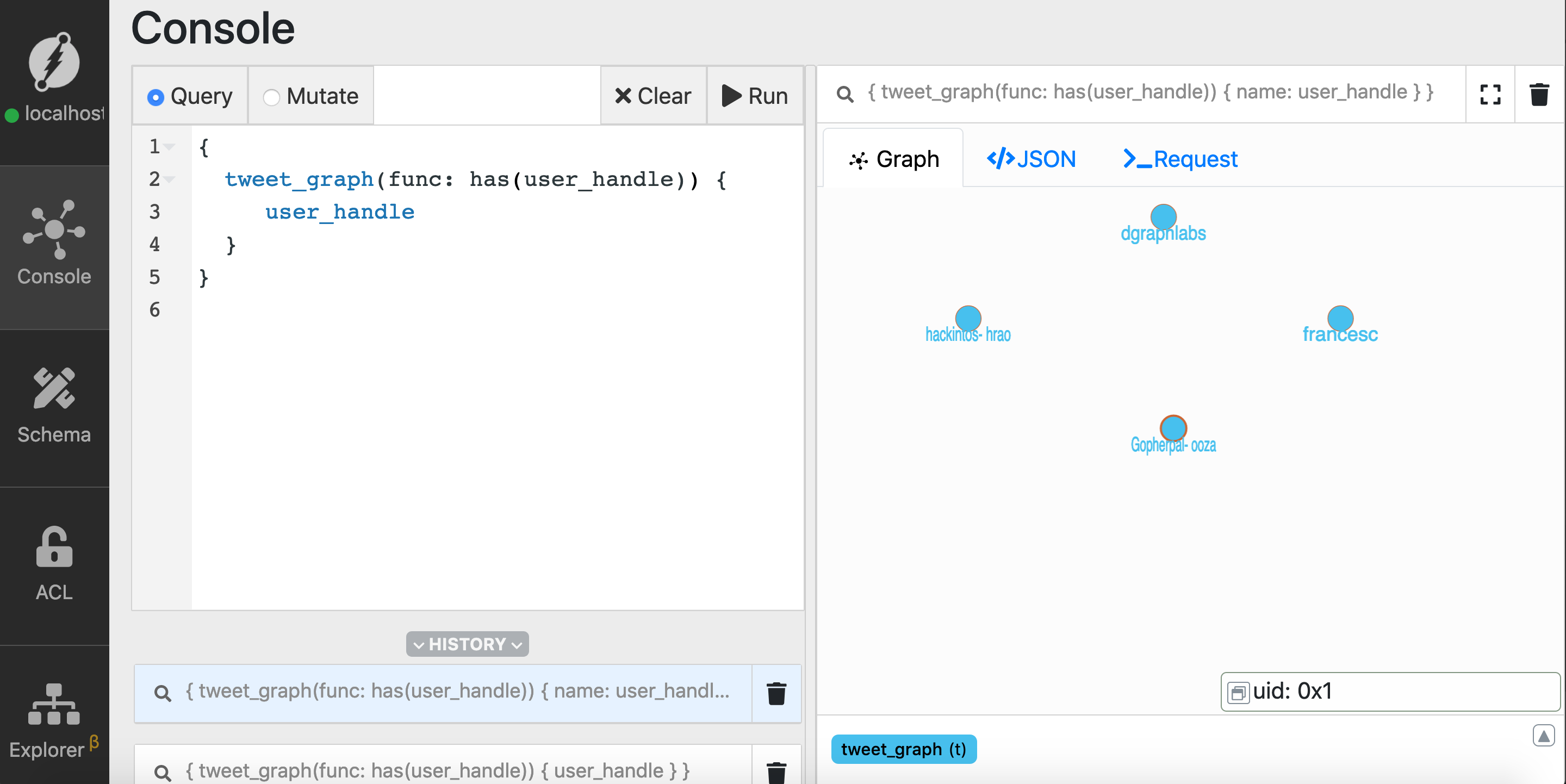
Note: If the query syntax above looks not so familiar to you, check out the first tutorial.
We have four twitter users: @hackintoshrao, @francesc, @dgraphlabs, and @gopherpalooza.
Now, let’s find their tweets and hashtags too.
{
tweet_graph(func: has(user_handle)) {
user_name
authored {
tweet
tagged_with {
hashtag
}
}
}
}
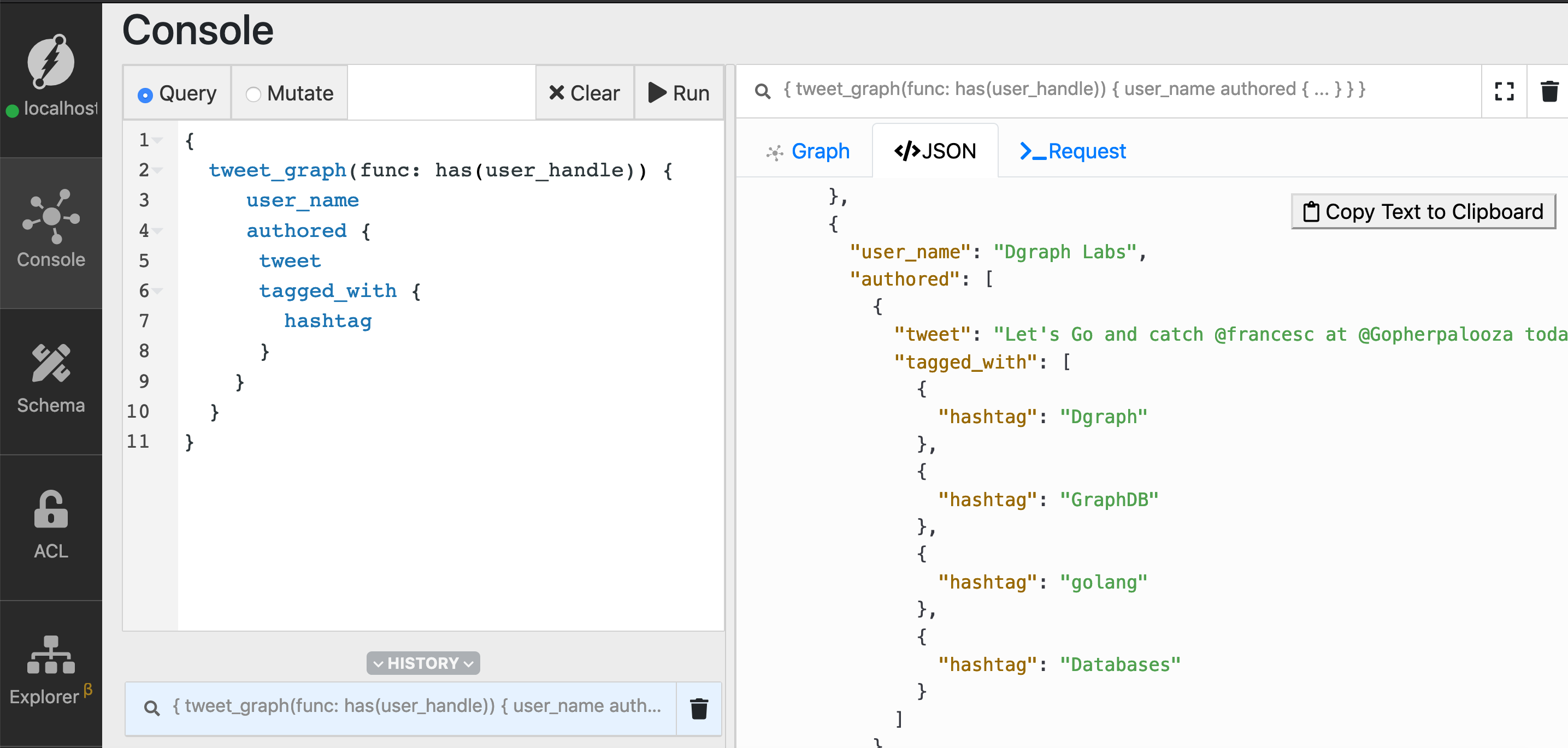 Note: If the traversal query syntax in the above query is not familiar to you, check out the third tutorial of the series.
Note: If the traversal query syntax in the above query is not familiar to you, check out the third tutorial of the series.
Before we start querying our graph, let’s learn a bit about database indices using a simple analogy.
What are indices?
Indexing is a way to optimize the performance of a database by minimizing the number of disk accesses required when a query is processed.
Consider a “Book” of 600 pages, divided into 30 sections. Let’s say each section has a different number of pages in it.
Now, without an index page, to find a particular section that starts with the letter “F”, you have no other option than scanning through the entire book. i.e: 600 pages.
But with an index page at the beginning makes it easier to access the intended information. You just need to look over the index page, after finding the matching index, you can efficiently jump to the section by skipping other sections.
But remember that the index page also takes disk space! Use them only when necessary.
In our next section,let’s learn some interesting queries on our twitter graph.
String indices and querying
Hash index
Let’s compose a query which says: Hey Dgraph, find me the tweets of user with twitter handle equals to hackintoshrao.
Before we do so, we need first to add an index has to the user_handle predicate.
We know that there are 5 types of string indices: hash, exact, term, full-text, and trigram.
The type of string index to be used depends on the kind of queries you want to run on the string predicate.
In this case, we want to search for a node based on the exact string value of a predicate.
For a use case like this one, the hash index is recommended.
Let’s first add the hash index to the user_handle predicate.

Now, let’s use the eq comparator to find all the tweets of hackintoshrao.
Go to the query tab, type in the query, and click Run.
{
tweet_graph(func: eq(user_handle, "hackintoshrao")) {
user_name
authored {
tweet
}
}
}
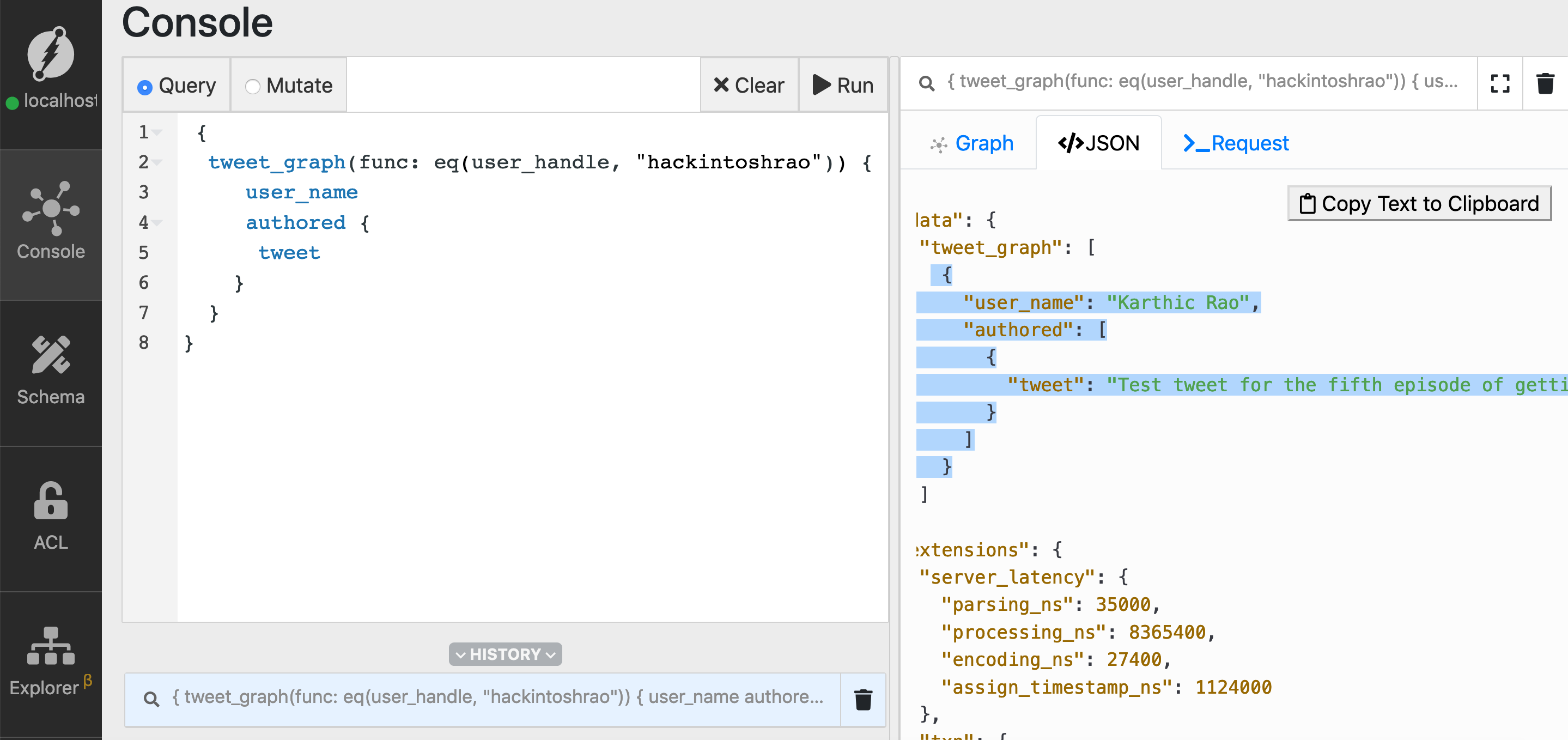 Note: Refer to the third tutorial, if you want to know about comparator functions like
Note: Refer to the third tutorial, if you want to know about comparator functions like eq in detail.
Let’s extend the last query also to fetch the hashtags and the mentions.
{
tweet_graph(func: eq(user_handle, "hackintoshrao")) {
user_name
authored {
tweet
tagged_with {
hashtag
}
mentioned {
user_name
}
}
}
}
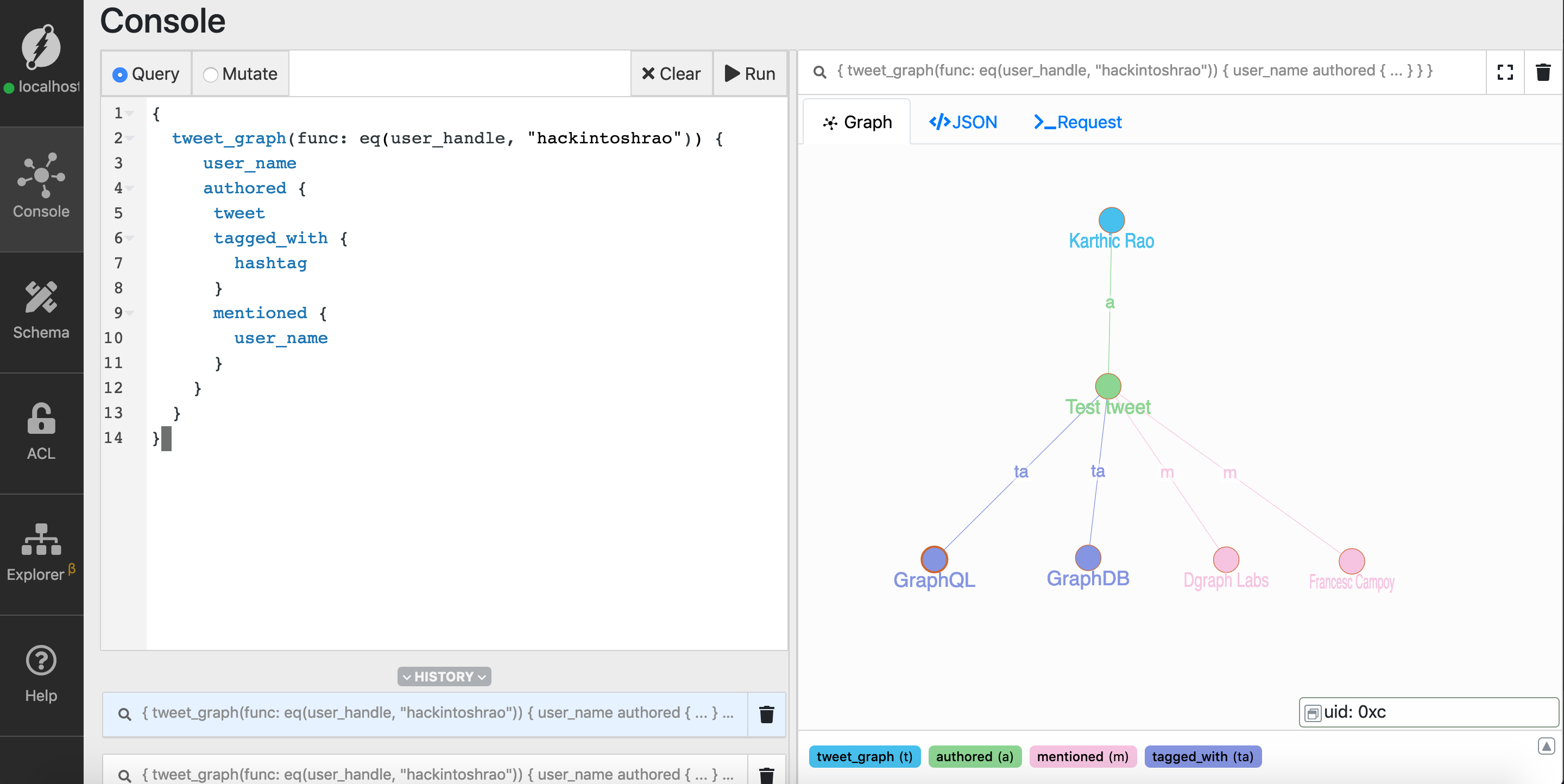 Note: If the traversal query syntax in the above query is not familiar to you, check out the third tutorial of the series.
Note: If the traversal query syntax in the above query is not familiar to you, check out the third tutorial of the series.
Did you know that string values in Dgraph can also be compared using comparators like greater-than or less-than?
In our next section, let’s see how to run the comparison functions other than equals to (eq) on the string predicates.
Exact Index
We discussed in the third tutorial that there five comparator functions in Dgraph.
Here’s a quick recap:
| comparator function name | Full form |
|---|---|
| eq | equals to |
| lt | less than |
| le | less than or equal to |
| gt | greater than |
| ge | greater than or equal to |
All five comparator functions can be applied to the string predicates.
We have already used the eq operator.
The other four are useful for operations, which depend on the alphabetical ordering of the strings.
Let’s learn about it with a simple example.
Let’s find the twitter accounts which come after dgraphlabs in alphabetically sorted order.
{
using_greater_than(func: gt(user_handle, "dgraphlabs")) {
user_handle
}
}
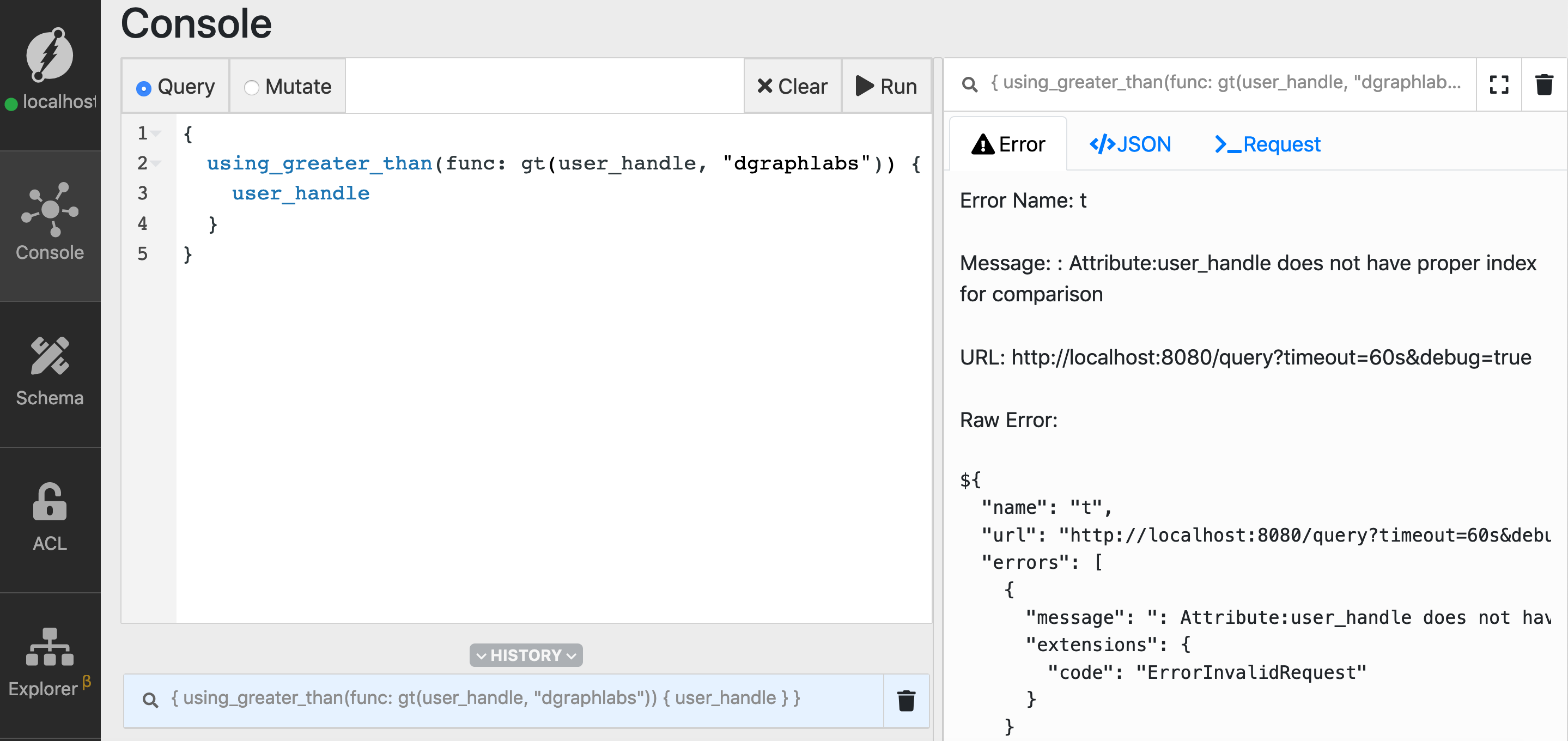 Oops, we have an error!
Oops, we have an error!
You can see from the error that the current hash index on the user_handle predicate doesn’t support the gt function.
To be able to do string comparison operations like the one above, you need first set the exact index on the string predicate.
The exact index is the only string index that allows you to use the ge, gt, le, lt comparators on the string predicates.
Remind you that the exact index also allows you to use equals to (eq) comparator.
But, if you want to just use the equals to (eq) comparator on string predicates, using the exact index would be an overkill.
The hash index would be a better option, as it is, in general, much more space-efficient.
Let’s see the exact index in action.
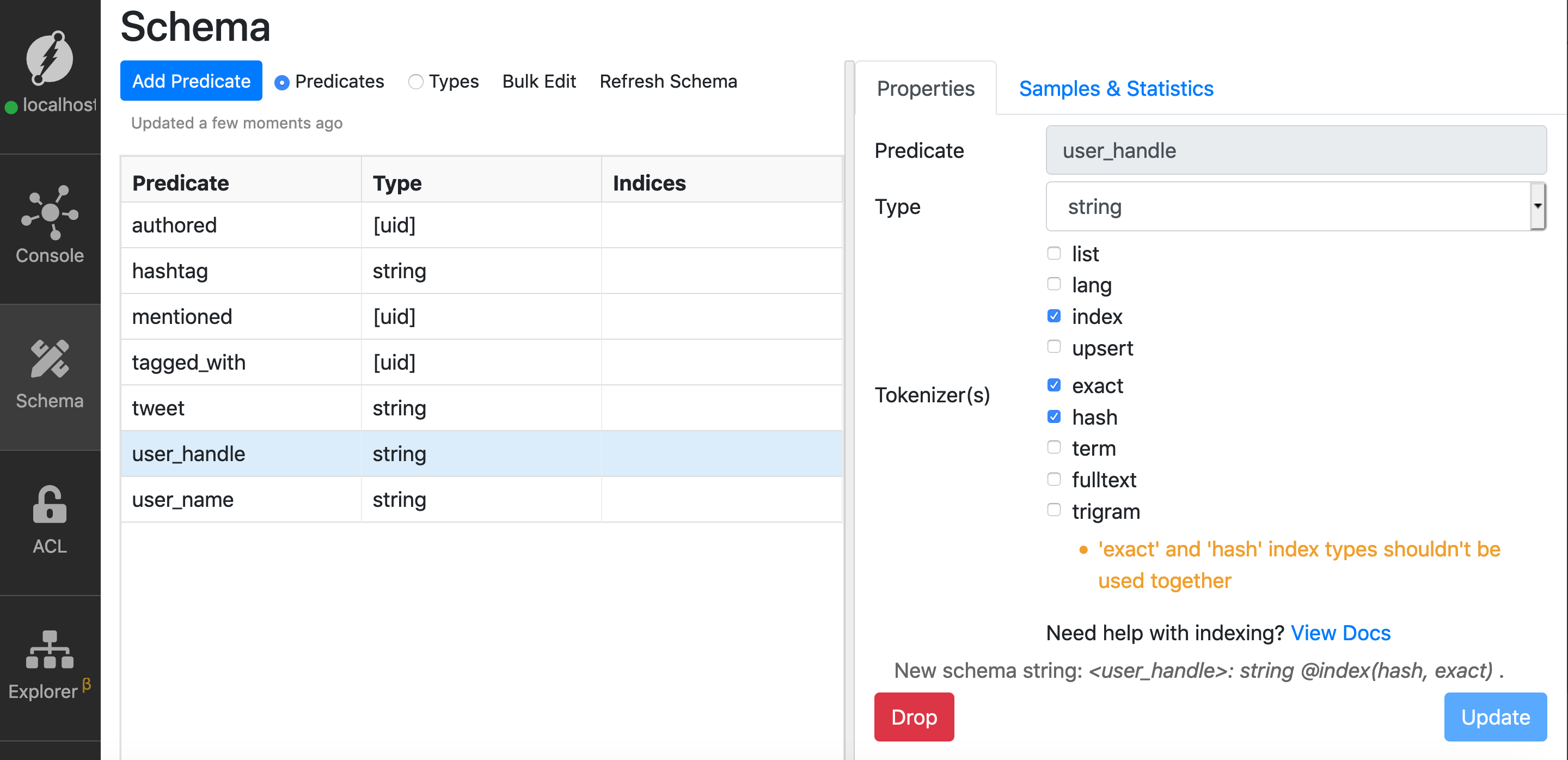 We again have an error!
We again have an error!
Though a string predicate can have more than one index, some of them are not compatible with each other.
One such example is the combination of the hash and the exact indices.
The user_handle predicate already has the hash index, so trying to set the exact index gives you an error.
Let’s uncheck the hash index for the user_handle predicate, select the exact index, and click update.

Though Dgraph allows you to change the index type of a predicate, do it only if it’s necessary. When the indices are changed, the data needs to be re-indexed, and this takes some computing, so it could take a bit of time. While the re-indexing operation is running, all mutations will be put on hold.
Now, let’s re-run the query.
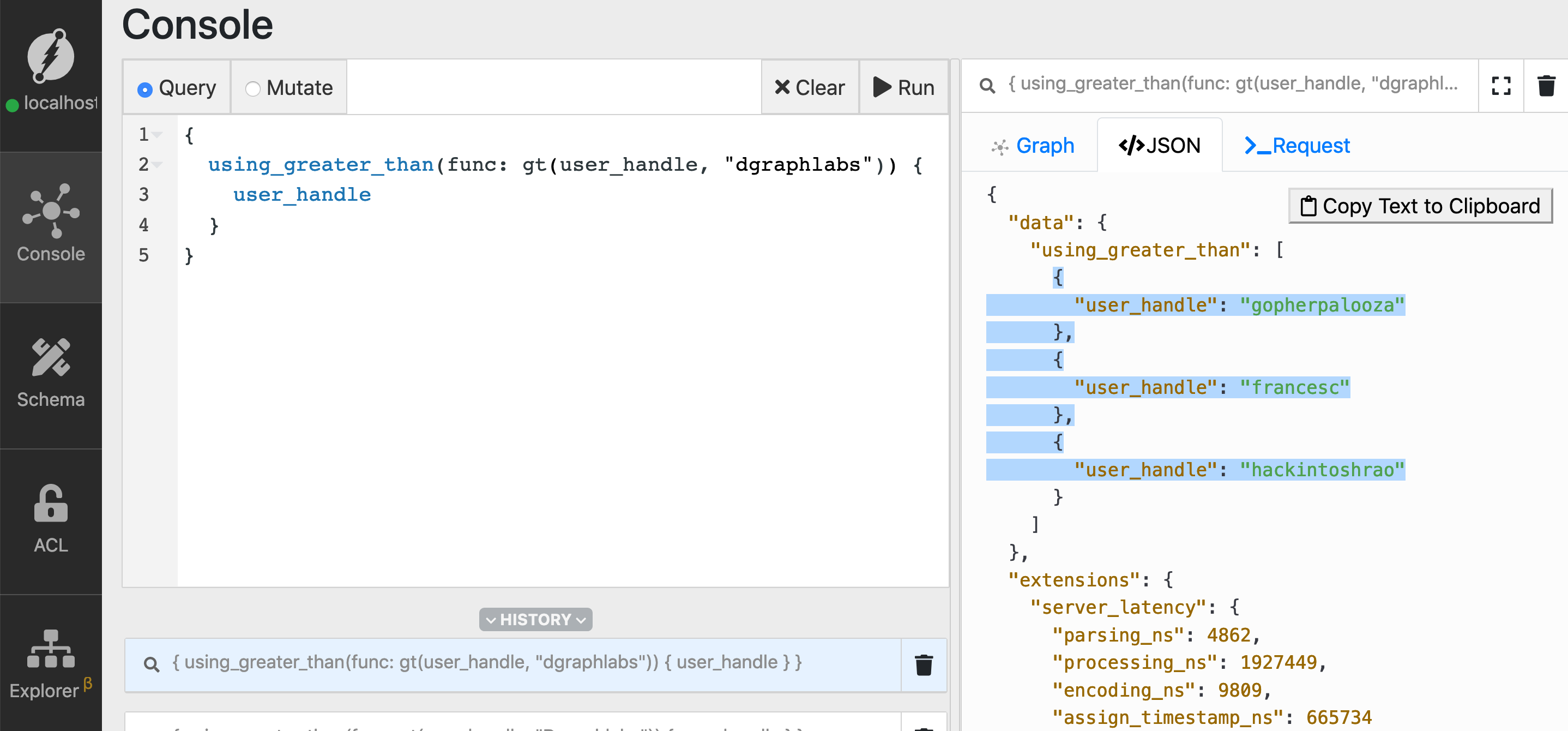
The result contains three twitter handles: francesc, gopherpalooza, and hackintoshrao.
In the alphabetically sorted order, these twitter handles are greater than dgraphlabs.
Some tweets appeal to us better than others.
For instance, I love Graphs and Go.
Hence, I would surely enjoy tweets that are related to these topics.
A keyword-based search is a useful way to find relevant information.
Can we search for tweets based on one or more keywords related to your interests?
Yes, we can! Let’s do that in our next section.
The Term index
The term index lets you search string predicates based on one or more keywords.
These keywords are called terms.
To be able to search tweets with specific keywords or terms, we need to first set the term index on the tweets.
Adding the term index is similar to adding any other string index.
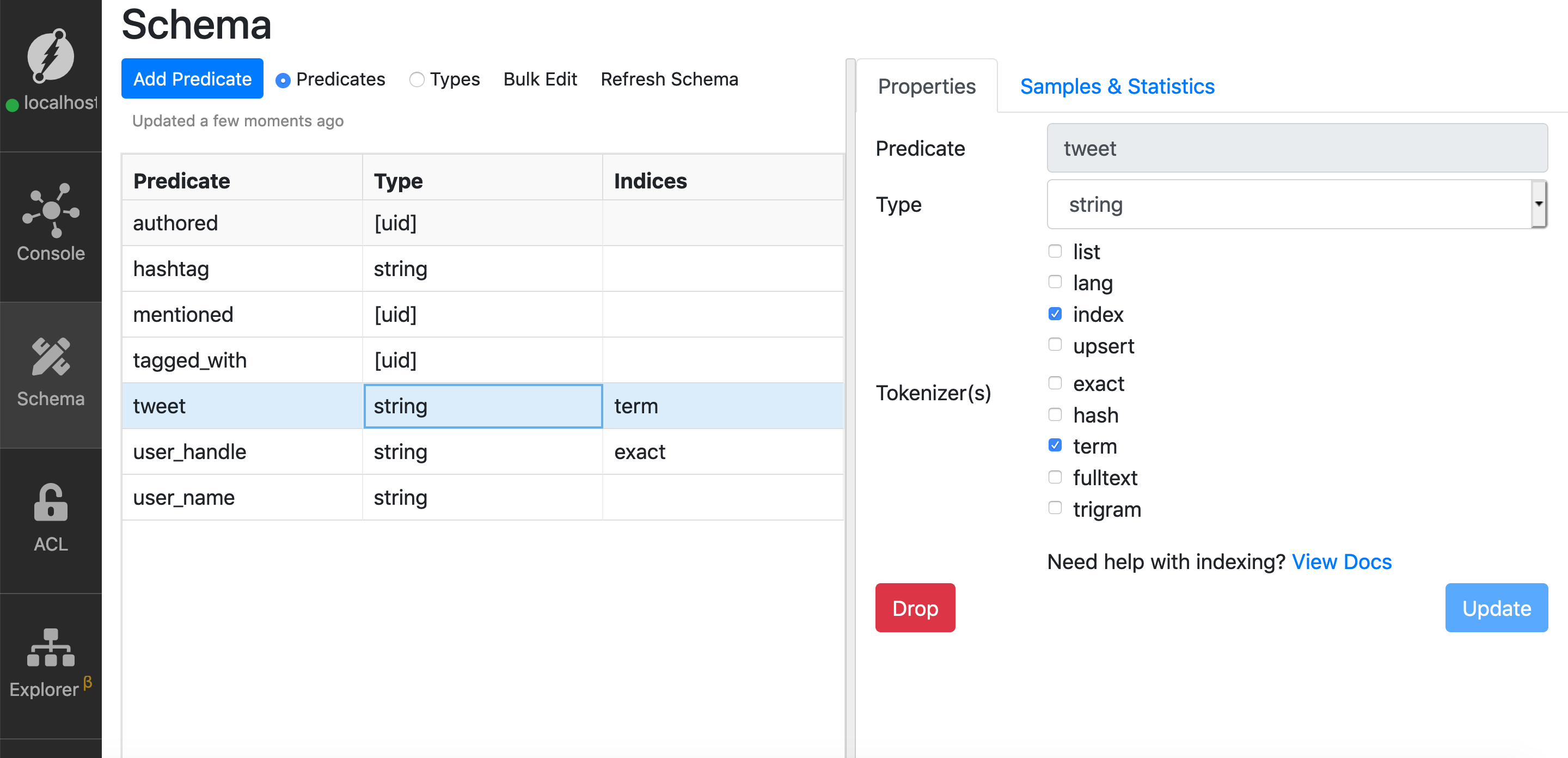
Dgraph provides two built-in functions specifically to search for terms: allofterms and anyofterms.
Apart from these two functions, the term index only supports the eq comparator.
This means any other query functions (like eq, lt, gt…) fails when run on string predicates with the term index.
We’ll soon take a look at the table containing the string indices and their supporting query functions.
But first, let’s learn how to use anyofterms and allofterms query functions.
Let’s write a query to find all tweets with terms or keywords Go or Graph in them.
Go the query tab, paste the query, and click Run.
{
find_tweets(func: anyofterms(tweet, "Go Graph")) {
tweet
}
}
Here’s the matched tweet from the query response:
{
"tweet": "Let's Go and catch @francesc at @Gopherpalooza today, as he scans into Go source code by building its Graph in Dgraph!\nBe there, as he Goes through analyzing Go source code, using a Go program, that stores data in the GraphDB built in Go!\n#golang #GraphDB #Databases #Dgraph "
}
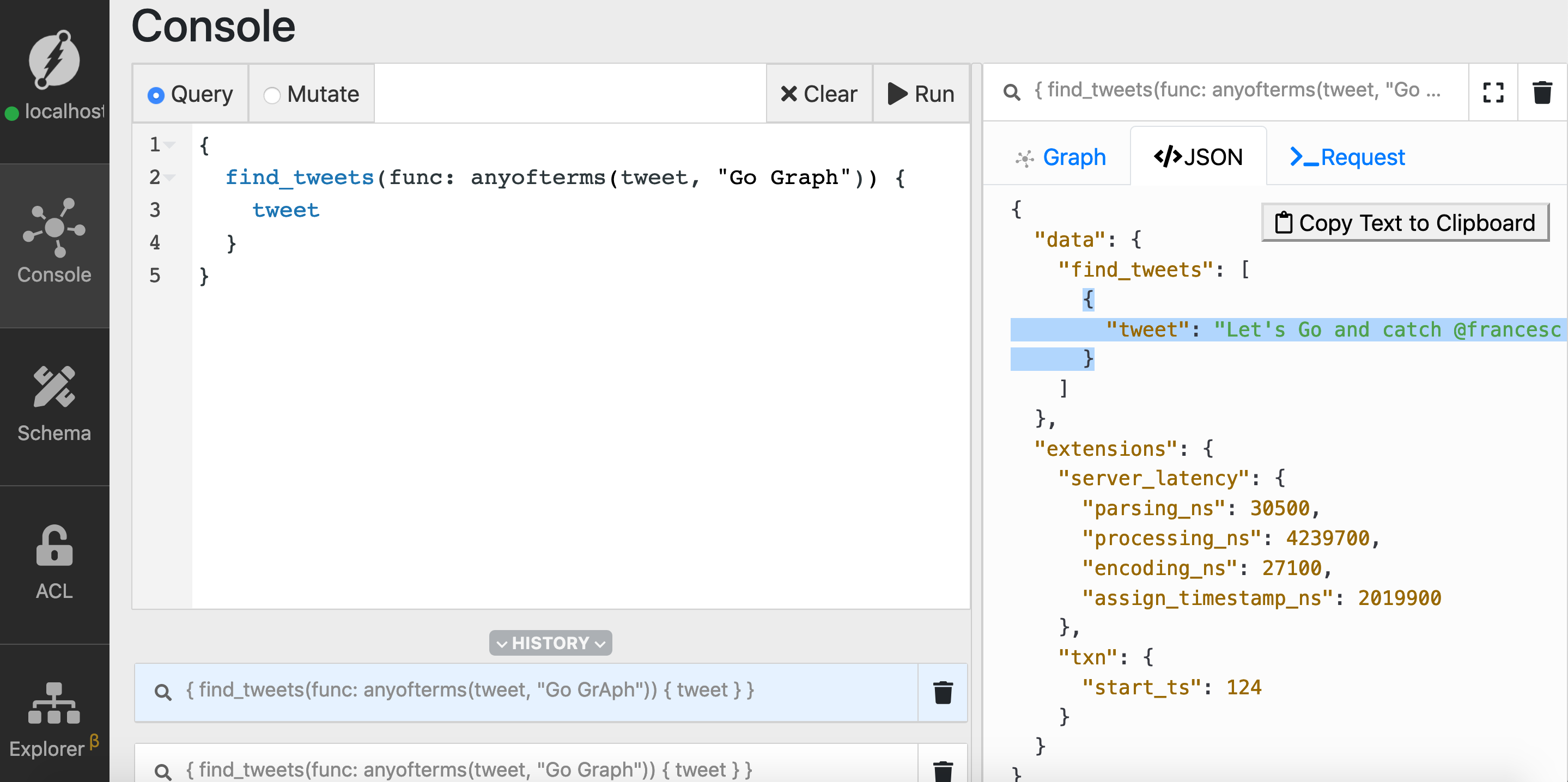 Note: Check out the first tutorial if the query syntax, in general, is not familiar to you
Note: Check out the first tutorial if the query syntax, in general, is not familiar to you
The anyofterms function returns tweets which have either of Go or Graph keyword.
In this case, we’ve used only two terms to search for (Go and Graph), but you can extend for any number of terms to be searched or matched.
The result has one of the three tweets in the database.
The other two tweets don’t make it to the result since they don’t have either of the terms Go or Graph.
It’s also important to notice that the term search functions (anyofterms and allofterms) are insensitive to case and special characters.
This means, if you search for the term GraphQL, the query returns a positive match for all of the following terms found in the tweets: graphql, graphQL, #graphql, #GraphQL.
Now, let’s find tweets that have either of the terms Go or GraphQL in them.
{
find_tweets(func: anyofterms(tweet, "Go GraphQL")) {
tweet
}
}
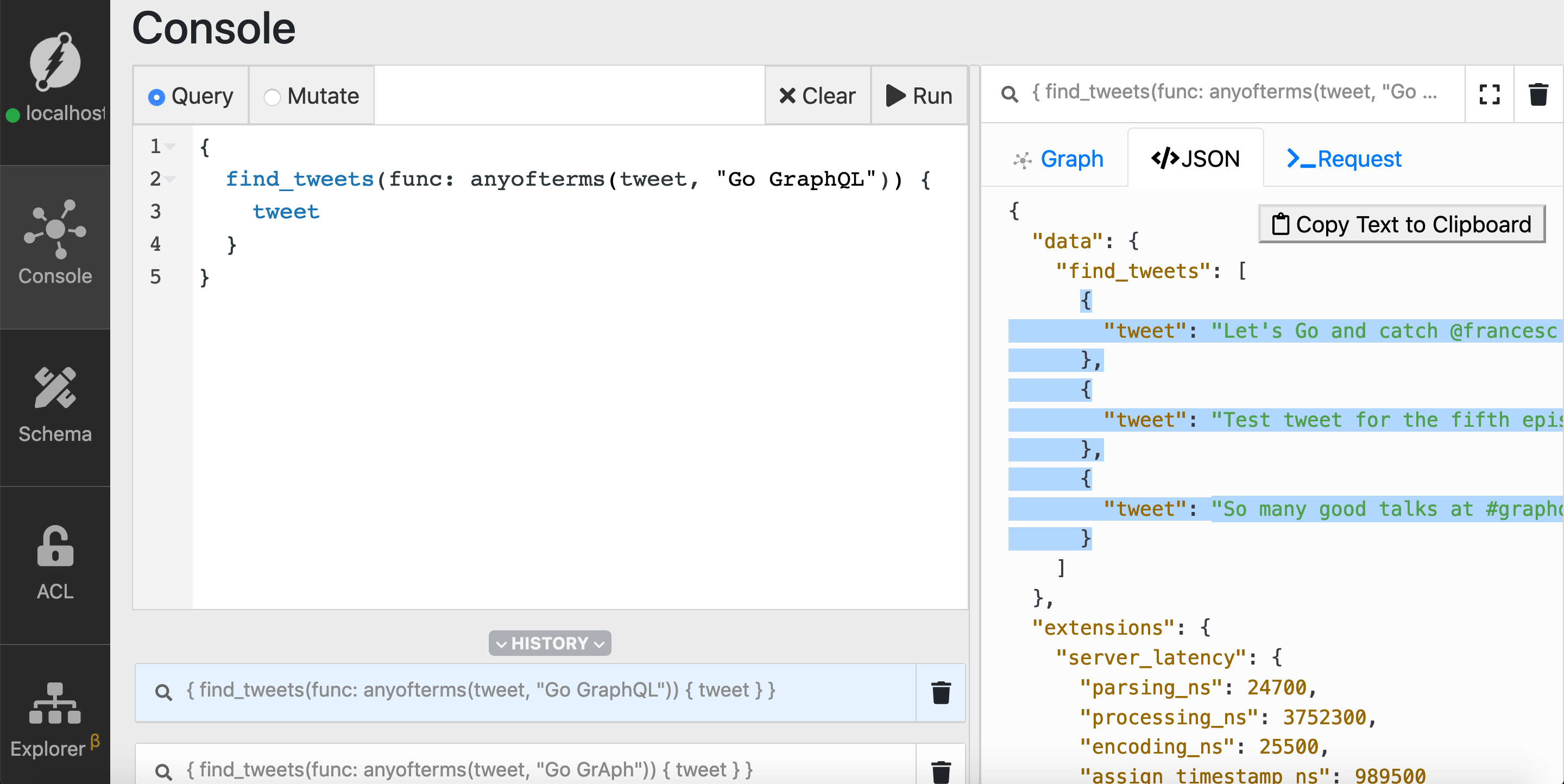
Oh wow, we have all the three tweets in the result.
This means, all of the three tweets have either of the terms Go or GraphQL.
Now, how about finding tweets that contain both the terms Go and GraphQL in them.
We can do it by using the allofterms function.
{
find_tweets(func: allofterms(tweet, "Go GraphQL")) {
tweet
}
}
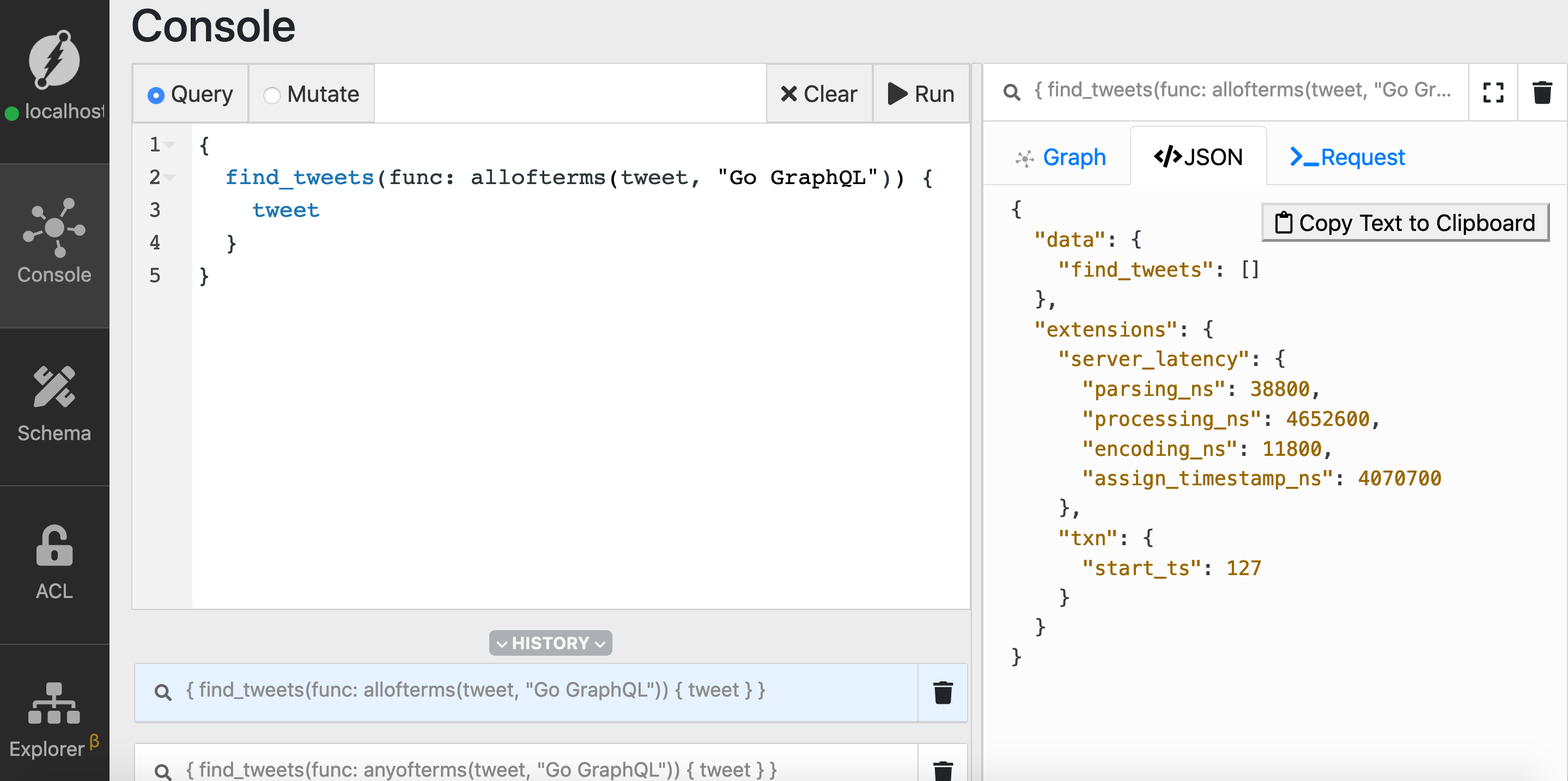
We have an empty result.
None of the tweets have both the terms Go and GraphQL in them.
Besides Go and Graph, I’m also a big fan of GraphQL and GraphDB.
Let’s find out tweets that contain both the keywords GraphQL and GraphDB in them.
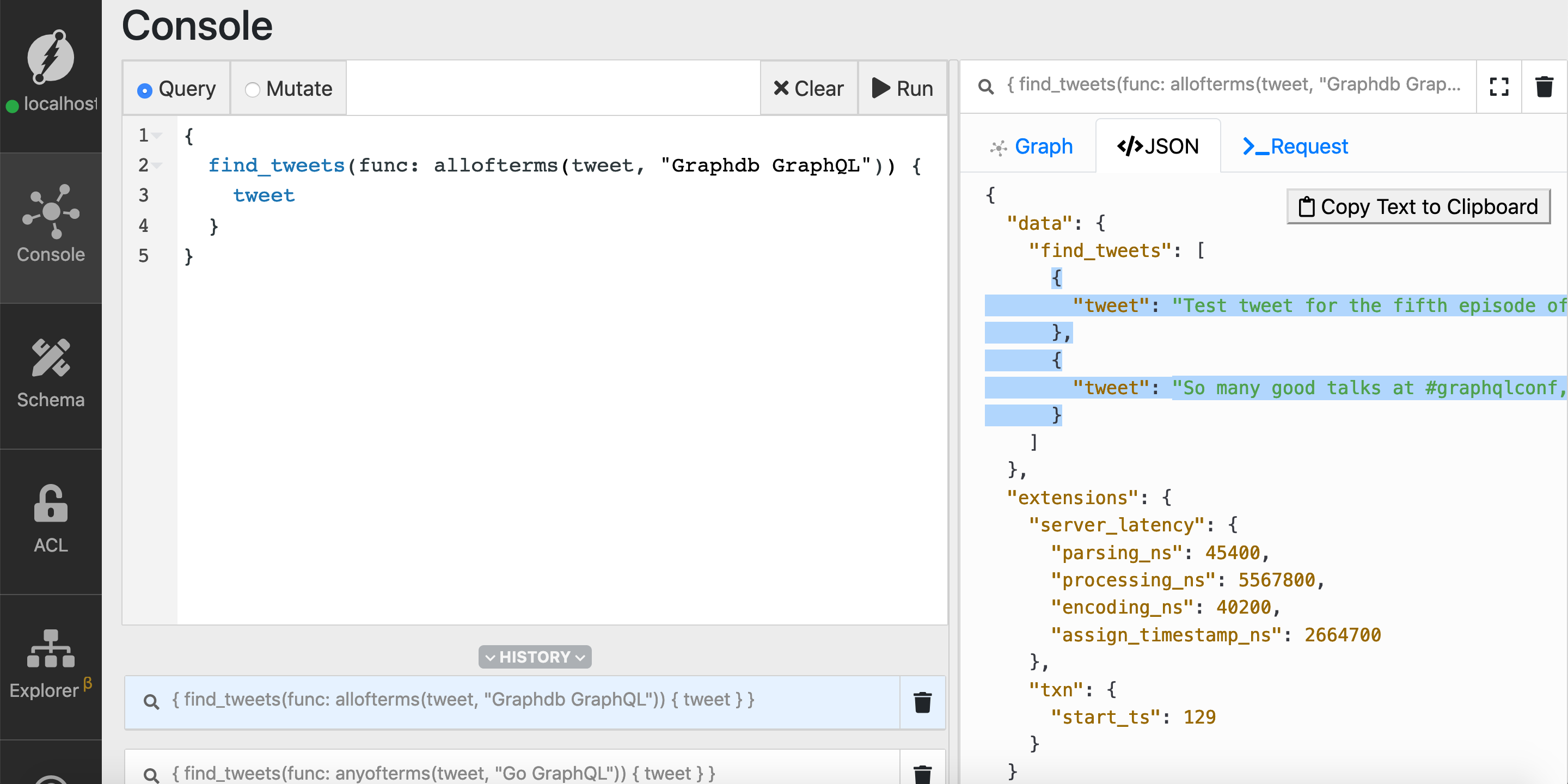
We have two tweets in a result which has both the terms GraphQL and GraphDB.
{
"tweet": "Test tweet for the fifth episode of getting started series with @dgraphlabs. Wait for the video of the fourth one by @francesc the coming Wednesday!\n#GraphDB #GraphQL"
},
{
"tweet": "So many good talks at #graphqlconf, next year I'll make sure to be *at least* in the audience!\nAlso huge thanks to the live tweeting by @dgraphlabs for alleviating the FOMO😊\n#GraphDB ♥️ #GraphQL"
}
Before we wrap up, here’s the table containing the three string indices we learned about, and their compatible built-in functions.
| Index | Valid query functions |
|---|---|
| hash | eq |
| exact | eq, lt, gt, le, ge |
| term | eq, allofterms, anyofterms |
Summary
In this episode, we modeled a series of tweets and set up the exact, term, and hash indices in order to query them.
Did you know that Dgraph also offers more powerful search capabilities like full-text search and regular expressions based search?
In the next episode, we’ll explore these features and learn about more powerful ways of searching for your favorite tweets!
Sounds interesting? Then see you all soon in the next tutorial. Till then, happy Graphing!
